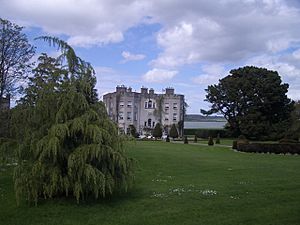Glin, County Limerick facts for kids
Quick facts for kids
Glin
Irish: An Gleann
|
|
|---|---|
|
Village
|
|

The N69 road passes through Glin
|
|
| Country | Ireland |
| Province | Munster |
| County | County Limerick |
| Population
(2022)
|
644 |
| Time zone | UTC+0 (WET) |
| • Summer (DST) | UTC-1 (IST (WEST)) |
Glin (Irish: An Gleann, meaning the glen) is a small village in the northwest of County Limerick, Ireland. It sits on the south side of the River Shannon's wide mouth, where the river meets the sea. You can find Glin on the N69 road, which connects Foynes and Tarbert. In 2022, about 644 people lived in the village.
History of Glin
The land around Glin was once owned by a powerful family called the Knight of Glin. This happened after the Normans arrived in Ireland. In the 1650s, Glin was known by a different name, Ballygullyhannane.
The name Glin, or An Gleann in Irish, used to be Gleann Corbraighe. This means "Valley of the Corbry," named after the stream that flows through the village into the Shannon River. Glin is part of an area called Shanid. A road was built through the mountains south to Abbeyfeale in 1836.
In 1850, Glin became home to a "poor law union," which helped people who were struggling. A large building called a workhouse was built for this purpose. Later, in 1894, this workhouse became a school. Boys were taught by the Christian Brothers, and girls by the Sisters of Mercy. The workhouse closed in 1920, and the school in 1924. In 1928, another school for boys, St Joseph’s industrial school, moved to this site. It was also run by the Christian Brothers and closed in 1966.
Glin Castle
Just up the Corbry stream from the village is Glin Castle. This beautiful building was once the home of the Knight of Glin family. Today, it is a fancy hotel.
The first castle built by this family was by Thomas Fitzgerald around the year 1200 in a place called Shanid. You can still see its old ruins. The Knights of Glin lived there from about 1260 until 1642. After that, a new house was built close to where the current castle stands.
The Glin Castle you see today was built between 1780 and 1790 by John Bateman. Even though it's called a castle, it's actually a grand Georgian-style house. The stone for the building was brought from Athea using horse-drawn sledges. By 1798, most of the inside was finished. However, the Fitzgerald family faced money problems, and the builders had to stop working and leave.
Shannon Lawn House
Near the River Shannon, there is an old Georgian house called Shannon Lawn House. It is believed that Sir Edmund Sexton Pery built it in the early 1800s. The house is still standing today. It has had many different owners over the years. Some local stories say that a ghost lives in the house. People believe this might be why owners often did not stay there for very long.
Culture in Glin
In the past, Glin had special market days. Fairs were held on June 8th, the first Wednesday in September, and December 3rd. There was also a weekly market every Wednesday.
Today, Glin hosts a fun yearly event called the Swim to Clare. During this event, local people swim across the Shannon River to or from County Clare, depending on the tide. Cycling events are also held throughout the year. This is because the town is located along the main N69 road, which is good for cycling.
Sport in Glin
Glin has a local Gaelic football club called Glin GAA club. This club has a proud history. They won seven county football championships between 1926 and 1934. Their main rivals include the Fr. Caseys and Newcastle West clubs. In 2009, the Glin club reached the County Junior Final, but they lost in a replay to Mountcollins.
See also
 In Spanish: Glin para niños
In Spanish: Glin para niños



